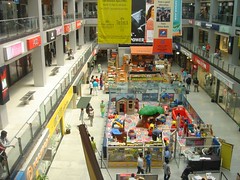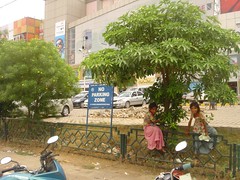

Left: Inside a mall in Gurgaon: all that glitters is not gold
Right: Outside, familiar scenes of child beggars, outside the malls
Two news reports on the same day and at the same site show the contradictions in the neo- liberal model that currently holds sway in India.
Here are two short extracts from the two reports:
Indian economy registered this decade's highest first quarter growth during the current financial year at 8.9 per cent on impressive showing by manufacturing and services sectors....Agriculture grew by a flat 3.4 per cent, chipping in 19.1 per cent to overall GDP growth.
(Indian economy booms; Q1 GDP growth at 8.9%)
On the other hand:
According to the National Sample Survey Organisation data, about 42 per cent of the population was employed during fiscal 2004-05, which meant that the remaining 58 per cent of the country's employable population was without jobs...Rural areas accounted for 44 per cent of the employed while urban India had 37 per cent of its population employed.
(More than 50% jobless in India in 2004-05)
In other words, the gains of the booming economy are impacting a small percentage of the urban population leaving a majority sweating outside.
The impact of this "boom" is manifested even in something as insignificant as the sale of books published in English in India with non- fiction books like Thomas Friedman's flawed The World is Flat and Amartya Sen's grossly insufficient The Argumentative Indian appealing to a "new class" of readers:
"There is a whole new class of readers emerging out of the Indian economic boom. This genre strikes a chord with their concerns," said Thomas Abraham, Penguin's president and chief executive officer.
(Fact more engaging than fiction for Indian readers)
There is some truth in Joseph Stiglitz's "prescription" in making globalization "work":
The prescription for making globalisation work is what is generally called "the Scandinavian model." That means high levels of investment in education, research, and technology plus a strong safety net. That of course also entails, as in the Scandinavian countries, a highly progressive income tax.
However, the proponents of the Narasimha Rao- Manmohan Singh neo- liberal economic model that has been the ruling paradigm since 1991 have little to show in terms of either trickle down effects of the policies or any semblance of following the Scandinavian model, a decade and half later after the sudden change of gear in the backdrop of a financial failure (though not an economic one).
The truth of the Manmohanomics model is glaring in the face with agricultural land being up for grabs, the suicides in the countryside unabating and the FDI, export lead model overly reliant on the assumption of a growing US economy.
However, it is unfair to compare India with the Scandinavian First World countries.
In the context of the rest of the Third World countries forging their their way into a globalized 21st century, rather than comparing India's economic model with the Scandinavian countries, it is instructive to see this comparative essay on South Africa and Venezuela- the former following the neo- liberal diktat and Hugo Chavez taking a different path, it is clear that India's direction is more akin to that of South Africa.
I can compare two countries taking two radically different approaches to their social development -- Venezuela trying to redistribute social services and opportunities, and South Africa trying to hold on to the failed economic policies of the past, in efforts that benefit the small elite of both whites and blacks but come at the direct expense of 60% or more of the population of all racial groupings. In Venezuela, I saw hope among the poor; in South Africa, dejection and dissatisfaction.
In terms of a political fallout, it is very easy to predict a defeat of the UPA by any ramshackle conglomeration in the next elections if the UPA government continues to follow its lop sided policies.
It is in the terms of social contradictions that this galloping but unequally distributed economic growth poses that is more difficult and scarier to imagine.
(Link to interview with Joseph Stiglitz via Abi and Krishworld)
The above article has been taken from Bhupinder Singh's Blog
Don't forget that the Scandinavian model (I think really we should talk about the Swedish model since the Scandinavian countries are all rather different) is an imperialist model: Sweden benefits from super-profits its industries realise from owning the means of production in poor countries.
ReplyDelete